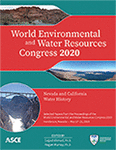World Environmental and Water Resources Congress 2020
How Boulder Canyon Dam Ended Up in Black Canyon as Hoover Dam
Publication: World Environmental and Water Resources Congress 2020: Nevada and California Water History
ABSTRACT
Investigations of potential dam sites along the lower Colorado River in Boulder and Black Canyons were initially carried out by the Hydrology Branch of the U.S. Geological Survey in 1901–02. These were further evaluated by the newly-formed Reclamation Service from 1914 until the dam’s eventual construction in 1931–35. The seminal event triggering these studies was the accidental flooding of the Imperial Valley in 1905–07, which inundated more than 500 square miles of irrigable lands. It was assumed that a great embankment dam would be constructed near the head of Boulder Canyon, where the gorge was narrowest and comprised of granite. At this location the average depths of channel sands and gravels was about 65 feet. The site’s location thereafter caused the federal effort to be part of the Boulder Canyon Project. In 1919 California representatives in the House and Senate began introducing bills to approve what would eventually become the largest line item appropriation in American history, up to that time. In 1922–24 Reclamation received funds to explore alternative dam sites in Black Canyon, 18 to 23 miles downstream of the Boulder Canyon site. Dams of similar height built 20 miles downstream would increase the reservoir storage by about 40%, but the average depth to bedrock in the river channel was 120 feet. In 1924 Reclamation recommended a concrete gravity arch dam 740 ft high in Black Canyon. During each session of Congress in the 1920s the Boulder Canyon Act was introduced but failed to win congressional approval for nine years. Along the way, it became a more multi-faceted project, providing irrigation to an enlarged area, increased flood storage, constructing an All-American Canal along the international border, and the novel proposal for Reclamation to construct and operate the world’s largest hydroelectric facility, using the proceeds to repay to cost of the project. In 1927 a board of advisors were appointed to make detailed surveys of the Lower Colorado River and answer five questions that had been raised by critics of the act. These refinements and concessions eventually led to congressional approval in May 1928, but with a special proviso resulting from the recent failure of the St. Francis Dam built by the city of Los Angeles, which had killed ~430 people. Congress appointed a Colorado River Board (CRB) comprised of eminent engineers and geologists to make a detailed evaluation of Reclamation’s designs and report their findings within six months. The CRB’s recommendations were accepted and the Boulder Canyon Act was approved by Congress and President Calvin Coolidge in December 1928.
Get full access to this article
View all available purchase options and get full access to this chapter.
REFERENCES
Committee of the Irrigation Division (1929). “A National Reclamation Policy.” Transactions ASCE, Vol. 95, pp. 1303-1418.
Emerson, F. C., W.F. Durand, J.G. Scrugham, and J. R. Garfield (1928). Development of the lower Colorado River: reports by special advisors to the Secretary of the Interior. U.S. Bureau of Reclamation, Government Printing Office, Wash., D.C., pp. 365-435.
Hiltzik, M. (2010). “Colossus: Hoover Dam and the making of the American Century.” Simon & Schuster.
Lyons, B. (1947). They subdued the desert: the story of irrigation as told to Barrow Lyons by the men who apply water, till the land and feed their flocks and herds. U.S. Bureau of Reclamation, Wash., DC.
Moeller, B. B. (1971). Phil Swing and Boulder Dam. University of California Press, Berkeley.
Nadeau, R.A. (1974). The Water Seekers, Revised Ed. Chalfant Press, Bishop.
Rogers, J. David, 2010, Hoover Dam: Evolution of the Dam’s Design: in R. L. Wiltshire, D.R. Gilbert, and J.R. Rogers, Eds., Hoover Dam 75th Anniversary History Symposium, American Society of Civil Engineers: pp. 85-123.
Rogers, J. David (2010). Hoover Dam: Scientific Studies, Name Controversy, Tourist Attraction, and Contributions to Engineering: in R. L. Wiltshire, D.R. Gilbert, and J.R. Rogers, Eds., Hoover Dam 75th Anniversary History Symposium, American Society of Civil Engineers: pp. 216-248.
Rogers, J. David (2014). The American Engineers Who Built the Panama Canal; in B. G. Dennis, Jr., Ed., Engineering the Panama Canal: A Centennial Retrospective, ASCE Press, pp. 112-349.
U.S. Bureau of Reclamation (1922). “Problems of Imperial Valley & vicinity.” U.S. Gov’t Printing Office, Wash., D.C., 326 p., 52 leaves.
Weymouth, F.E. (1924). Colorado River Development. Senate Document No. 186, 70th Congress, 2nd Session, 231 p.
Information & Authors
Information
Published In
World Environmental and Water Resources Congress 2020: Nevada and California Water History
Pages: 66 - 80
Editors: Sajjad Ahmad, Ph.D., and Regan Murray, Ph.D.
ISBN (Online): 978-0-7844-8299-5
Copyright
© 2020 American Society of Civil Engineers.
History
Published online: May 14, 2020
Published in print: May 14, 2020
Authors
Metrics & Citations
Metrics
Citations
Download citation
If you have the appropriate software installed, you can download article citation data to the citation manager of your choice. Simply select your manager software from the list below and click Download.
